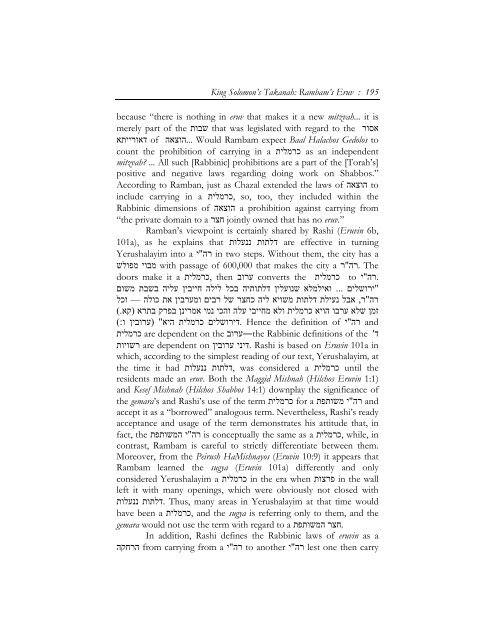King Solomon's Takanah: Rambam's Eruv - Hakirah.org
King Solomon's Takanah: Rambam's Eruv - Hakirah.org
King Solomon's Takanah: Rambam's Eruv - Hakirah.org
You also want an ePaper? Increase the reach of your titles
YUMPU automatically turns print PDFs into web optimized ePapers that Google loves.
<strong>King</strong> Solomon’s <strong>Takanah</strong>: Rambam’s <strong>Eruv</strong> : 195<br />
because “there is nothing in eruv that makes it a new mitzvah... it is<br />
אסור that was legislated with regard to the שבות merely part of the<br />
Would Rambam expect Baal Halachos Gedolos to ...הוצאה of ייתא<br />
count the prohibition of carrying in a ית as an independent<br />
mitzvah? ... All such [Rabbinic] prohibitions are a part of the [Torah’s]<br />
positive and negative laws regarding doing work on Shabbos.”<br />
According to Ramban, just as Chazal extended the laws of הוצאה to<br />
include carrying in a ,כרמלית so, too, they included within the<br />
Rabbinic dimensions of הוצאה a prohibition against carrying from<br />
“the private domain to a חצר jointly owned that has no eruv.”<br />
Ramban’s viewpoint is certainly shared by Rashi (<strong>Eruv</strong>in 6b,<br />
101a), as he explains that עלות are effective in turning<br />
Yerushalayim into a רה "י in two steps. Without them, the city has a<br />
. The "ר with passage of 600,000 that makes the city a מבוי מפולש<br />
. "י to כרמלית converts the ערוב then ,כרמלית doors make it a<br />
...<br />
כרמל<br />
דלתות ננ<br />
דאור<br />
רה<br />
רה<br />
"ירושלים ואילמלא שנועלין דלתותיה בכל לילה חייבין עליה בשבת משום<br />
רה"ר, אבל נעילת דלתות משויא ליה כחצר של רבים ומערבין את כולה — וכל<br />
זמן שלא ערבו הויא כרמלית ולא מחייבי עלה והכי נמי אמרינן בפרק בתרא (קא.)<br />
דירושלים כרמלית היא" (ערובין ו:<br />
( . Hence the definition of רה "י and<br />
ד ' the the―ערוב Rabbinic definitions of are dependent on the כרמלית<br />
Rashi is based on <strong>Eruv</strong>in 101a in .דיני ערובין are dependent on רשויות<br />
which, according to the simplest reading of our text, Yerushalayim, at<br />
the time it had ננעלות ,דלתות was considered a כרמלית until the<br />
residents made an eruv. Both the Maggid Mishnah (Hilchos <strong>Eruv</strong>in 1:1)<br />
and Kesef Mishnah (Hilchos Shabbos 14:1) downplay the significance of<br />
the gemara’s and Rashi’s use of the term כרמלית for a "<br />
accept it as a “borrowed” analogous term. Nevertheless, Rashi’s ready<br />
acceptance and usage of the term demonstrates his attitude that, in<br />
fact, the המשותפת is conceptually the same as a ,כרמלית while, in<br />
contrast, Rambam is careful to strictly differentiate between them.<br />
Moreover, from the Peirush HaMishnayos (<strong>Eruv</strong>in 10:9) it appears that<br />
Rambam learned the sugya (<strong>Eruv</strong>in 101a) differently and only<br />
considered Yerushalayim a כרמלית in the era when פרצות in the wall<br />
left it with many openings, which were obviously not closed with<br />
Thus, many areas in Yerushalayim at that time would .דלתות ננעלות<br />
have been a ,כרמלית and the sugya is referring only to them, and the<br />
.חצר המשותפת gemara would not use the term with regard to a<br />
In addition, Rashi defines the Rabbinic laws of eruvin as a<br />
and רה י משותפת<br />
רה "י<br />
lest one then carry רה "י to another רה "י from carrying from a הרחקה
















